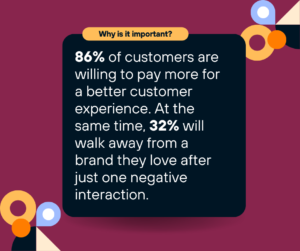Delivering a superior customer experience (CX) is more crucial than ever. Companies that place customers at the heart of their operations not only gain a competitive edge but also foster long-term loyalty, increase revenue, and build stronger brand reputations. A carefully constructed CX strategy ensures that every interaction a customer has with your organization is purposeful, seamless, and enjoyable.
In this guide, we’ll walk through the essential components of a robust CX strategy, why it is so important, and how your organization can develop one that drives measurable results. We’ll also explore how Knometrix can assist you in crafting a winning CX strategy that aligns with your business goals.
Why a Strong CX Strategy is Essential

Customer expectations have evolved dramatically. Today’s consumers are more informed and more demanding, seeking experiences that are personalized, seamless, and hassle-free. Research indicates that 86% of customers are willing to pay more for a better customer experience. At the same time, 32% will walk away from a brand they love after just one negative interaction. This makes CX not just a priority, but a fundamental business strategy.
A well-executed CX strategy delivers multiple benefits:
- Increased customer loyalty and retention: Satisfied customers are more likely to return and engage in repeat business.
- Enhanced brand advocacy: Customers who have positive experiences are more likely to recommend your brand to others.
- Improved operational efficiency: Understanding the customer journey allows businesses to streamline processes and reduce inefficiencies.
- Higher profitability: Happy customers spend more, stay longer, and drive better overall financial results.
Key Components of a Successful CX Strategy
Building a comprehensive CX strategy involves more than just addressing customer complaints or enhancing customer service. It requires an organization-wide effort to consistently deliver positive experiences across all touchpoints. Below are the steps that should be part of your strategy:
1. Gain Deep Customer Insights
The foundation of any strong CX strategy is an in-depth understanding of your customer base. This begins with data collection. By analyzing customer demographics, behaviors, and pain points, you can create customer personas that represent the needs and preferences of different segments of your audience.
The methods for collecting customer data include surveys, user interviews, focus groups, and website analytics. This research will enable you to identify customer expectations and areas where your organization can improve. Remember that understanding customers isn’t a one-time effort; their needs evolve over time, requiring ongoing research and engagement.
2. Map the Customer Journey
A customer journey map is a visual representation of every interaction a customer has with your brand, from the moment they become aware of your business to the point of purchase and beyond. Journey mapping helps you see the experience from the customer’s perspective, allowing you to identify critical touchpoints and potential pain areas.
Some common stages of the customer journey include:
- Awareness: How do customers first learn about your brand?
- Consideration: What information do customers seek when evaluating your products or services?
- Purchase: Is the purchase process smooth, and are there any barriers that need to be addressed?
- Post-Purchase: How do you ensure customers continue to have a positive experience after the sale?
By identifying these stages, you can optimize each step to ensure a seamless experience.
3. Align Your Organization Around the Customer
One of the common challenges in implementing a CX strategy is organizational silos. Different teams, such as marketing, sales, product, and customer service, often operate independently, leading to inconsistent customer experiences. To build a successful CX strategy, all departments need to work collaboratively and align their goals around the customer.
This can be achieved through internal communication strategies, shared performance metrics, and fostering a company culture that values customer-centric thinking. For instance, marketing should align with customer service to ensure brand messaging is consistent across all platforms, while product teams should work closely with sales to ensure customer feedback is integrated into product development.
4. Leverage Personalization
Personalization is no longer optional—it’s expected by customers. According to a recent study, 71% of customers expect companies to deliver personalized interactions. Personalization means delivering experiences that are tailored to individual customers based on their preferences, purchase history, and behaviors.
To achieve personalization, organizations must use customer data strategically. For example, marketing campaigns can be personalized based on previous interactions, while customer service teams can provide customized responses based on a customer’s history with the brand. This level of individual attention can significantly enhance customer satisfaction.
5. Develop Metrics and KPIs
A CX strategy is only effective if it can be measured. Establishing clear, quantifiable goals is crucial to understanding whether your strategy is working. Some important metrics to track include:
- Customer Satisfaction (CSAT): Measures how satisfied customers are with your products or services.
- Net Promoter Score (NPS): Assesses the likelihood that a customer will recommend your brand to others.
- Customer Effort Score (CES): Evaluates how easy it is for customers to interact with your business.
- Customer Retention Rate: Tracks the percentage of customers who continue to do business with your company over time.
These KPIs will provide insights into areas where you excel and those that need improvement, allowing for continuous optimization of your CX strategy.
6. Implement Feedback Loops
Building a robust CX strategy is not a one-and-done effort. It requires continuous monitoring, feedback, and refinement. Implementing feedback loops ensures that you are staying connected to your customers’ needs and adapting your strategy based on their evolving expectations.
Make it easy for customers to provide feedback through surveys, reviews, and customer support channels. This data can then be used to make informed decisions about changes to processes, product features, or service improvements. Feedback loops also demonstrate to customers that you value their opinions, strengthening trust and loyalty.
Conclusion: How Knometrix Can Help You Build a Winning CX Strategy
At Knometrix, we understand that developing an effective CX strategy can be challenging. With our deep expertise in user research, product-market fit, and data-driven insights, we can help you craft a CX strategy that is not only aligned with your business goals but also tailored to your customers’ unique needs.
Our approach includes:
- Conducting thorough customer research to identify key insights.
- Mapping out comprehensive customer journeys that highlight opportunities for improvement.
- Aligning your teams to ensure every department is focused on delivering a consistent and exceptional customer experience.
- Implementing feedback systems to ensure continuous improvement.
By partnering with Knometrix, you can create a CX strategy that drives loyalty, increases customer lifetime value, and positions your organization for long-term success. Whether you’re just beginning to build your CX approach or looking to refine an existing strategy, we’re here to help every step of the way.
Building a customer-centric organization is an ongoing journey, but with the right strategy in place, you can turn your customers into brand advocates and secure lasting success. Let Knometrix guide you in transforming your customer experience into a powerful competitive advantage.






 Market Research
Market Research Consumer Research
Consumer Research Industry Research
Industry Research Market Entry Strategy
Market Entry Strategy Feasibility Studies
Feasibility Studies Product Research
Product Research User Research
User Research Automobile & Mobility
Automobile & Mobility Banking and Finance
Banking and Finance Consumer Products & FMCG
Consumer Products & FMCG Ecommerce & Retail
Ecommerce & Retail Industry & Manufacturing
Industry & Manufacturing Government & Public Sector
Government & Public Sector Industry Associations
Industry Associations Technology & Software
Technology & Software Venture Capital & PE
Venture Capital & PE Consulting & Advisory
Consulting & Advisory India Entry Market Research
India Entry Market Research Innovation Consulting
Innovation Consulting KX Market Radar
KX Market Radar Business Model Development
Business Model Development Gen Z Navigator
Gen Z Navigator